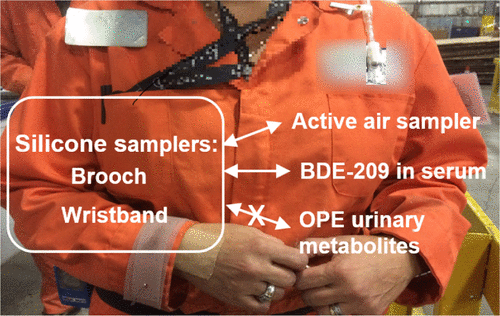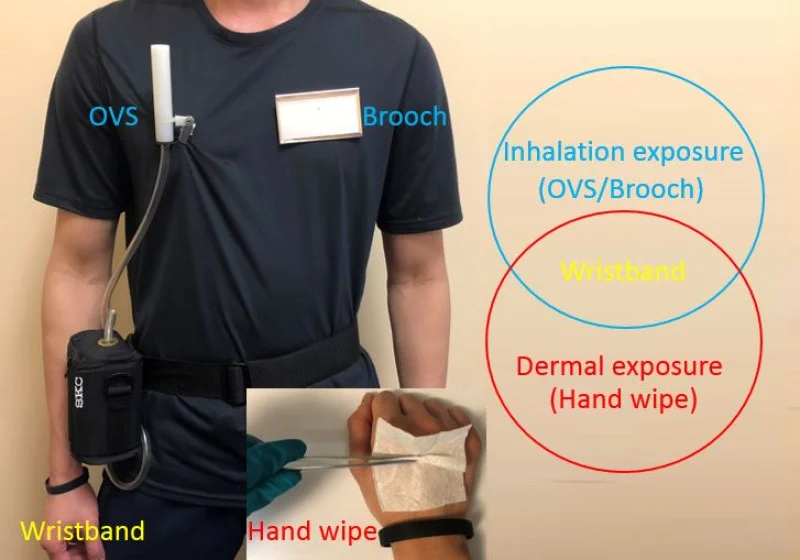Silicone passive samplers were assessed for measuring personal exposure to 37 flame retardants at three Québec e-waste recycling facilities. Silicone brooches (n = 45), wristbands (n = 28), and armbands (n = 9) worn during a ∼8 h work shift accumulated detectable amounts of 95–100% of the target compounds. Brooch concentrations were significantly correlated with those from active air samplers from which we conclude that the brooches could be used to approximate inhalation exposure and other exposures related to air concentrations such as dermal exposure. The generic sampling rate of the brooch (19 ± 11 m3 day–1 dm–2) was 13 and 22 times greater than estimated for home and office environments, respectively, likely because of the dusty work environment and greater movement of e-waste workers. BDE-209 concentrations in brooches and wristbands were moderately and significantly (p < 0.05) correlated with levels in blood plasma; organophosphorus esters in brooches and wristbands were weakly and insignificantly correlated with their metabolite biomarkers in post-shift spot urine samples. Silicone brooches and wristbands deployed over a single shift in a dusty occupational setting can be useful for indicating the internal exposure to compounds with relatively long biological half-lives, but their use for compounds with relatively short half-lives is not clear and may require either a longer deployment time or an integrated biomarker measure.
Research suggests that thyroid cancer incidence rates are increasing, and environmental exposures have been postulated to be playing a role. To explore this possibility, we conducted a pilot study to investigate the thyroid disrupting bioactivity of chemical mixtures isolated from personal silicone wristband samplers within a thyroid cancer cohort. Specifically, we evaluated TRβ antagonism of chemical mixtures extracted from wristbands (n = 72) worn by adults in central North Carolina participating in a case–control study on papillary thyroid cancer. Sections of wristbands were solvent-extracted and analyzed via mass spectrometry to quantify a suite of semivolatile chemicals. A second extract from each wristband was used in a bioassay to quantify TRβ antagonism in human embryonic kidney cells (HEK293/17) at concentrations ranging from 0.1 to 10% of the original extract (by volume). Approximately 70% of the sample extracts tested at a 1% extract concentration exhibited significant TRβ antagonism, with a mean of 30% and a range of 0–100%. Inhibited cell viability was noted in >20% of samples that were tested at 5 and 10% concentrations. Antagonism was positively associated with wristband concentrations of several phthalates, organophosphate esters, and brominated flame retardants. These results suggest that personal passive samplers may be useful in evaluating the bioactivities of mixtures that people contact on a daily basis. We also report tentative associations between thyroid receptor antagonism, chemical concentrations, and papillary thyroid cancer case status. Future research utilizing larger sample sizes, prospective data collection, and measurement of serum thyroid hormone levels (which were not possible in this study) should be utilized to more comprehensively evaluate these associations.
Compared to the general population, firefighters are known to sustain greater levels of exposure to hazardous compounds, despite their personal protective equipment, also known as turnout gear. Among the most significant toxins that firefighters are chronically exposed to are polycyclic aromatic hydrocarbons (PAHs). Additionally, firefighters have also been noted to exhibit an increased incidence of certain types of cancer. Considering a probable link between exposure to PAHs and increased rates of cancer in the fire service, we aim to document ambient chemical concentrations in the firefighter work environment. Our strategy involves the use of silicone-based wristbands that have the capacity to passively sorb PAHs. To determine if wristbands can serve as an effective chemical monitoring device for the fire service, silicone wristbands were pilot-tested as personal sampling devices for work environment risk monitoring in active-duty firefighters. Recovered wristbands underwent multiple extraction steps, followed by GC-MS analysis to demonstrate their efficacy in monitoring PAHs in the firefighter environment. Initial findings from all wristband samples taken from firefighters showed multiple exposures to various PAHs of concern for the health of the firefighters when in a fire environment. In addition to PAH monitoring, we examined known and potential sources of PAH contamination in their work environment. To that end, profiles of elevated PAH concentrations were documented at various fire stations throughout South Florida, for individual firefighters both during station duties and active fire response.
Silicone (polydimethylsiloxane or PDMS) wristbands and cotton T-shirts were used to assess the exposure of e-waste recyclers in Dhaka, Bangladesh to polybrominated diphenyl ethers (PBDEs), novel brominated flame retardants (NBFRs), dechlorane plus (DPs), and organophosphate esters (OPEs). The median surface-normalized uptake rates of PBDEs, NBFRs, DPs, and OPEs were 170, 8.5, 4.8, and 270 ng/dm2/h for wristbands and 5.4, 2.0, 0.94, and 23 ng/dm2/h for T-shirts, respectively. Concentrations of Tris(2-chloroethyl) phosphate (TCEP), Tris(1,3-dichloro-2-propyl) phosphate (TDCIPP), Tri-m-cresyl phosphate (TmCP), Bis(2-ethlyhexyl) tetrabromophthalate (BEH-TEBP), and Dechlorane plus (DPs) in wristbands were significantly correlated with those in T-shirts. Wristbands accumulated ~7 times more mass than T-shirts, especially of compounds expected to be mainly in the gas phase. We introduce the silicone “sandwich” method to approximate the easily releasable fraction (ERF) from T-shirts, hypothesized to be related to dermal exposure. ERFs varied from 6 to 75% of total chemical accumulated by T-shirts and were significantly negatively correlated with compounds' octanol-air partition coefficient (log Koa). The median daily exposure doses via dermal transfer from the front of the T-shirt to the front body trunk were 0.32, 0.13, 0.11, and 9.1 ng/kg-BW/day for PBDEs, NBFRs, DPs, and OPEs, respectively. The evidence of e-waste recycler exposure to flame retardants in this low income country, lacking protective personal equipment, calls for measures to minimize their exposure and for chemical management regulations to consider exposures to chemicals in waste products.
Organophosphate esters (OPEs) are applied as additive flame retardants, and along with phthalates, are also used as plasticizers in consumer products. As such, human exposure is common and chronic. Deployed as personal passive samplers, silicone wristbands have been shown to detect over a thousand industrial and consumer product chemicals; however, few studies have evaluated chemical concentrations with their corresponding biomarkers of exposure, especially in children.
The HPLC data showed that silicone wristbands are capable of adsorbing the selected OGSR compounds in laboratory settings. Compounds appeared to adsorb better individually than as a mix. This paper details the careful method development for the analysis of OGSR extracted from silicone bracelet. It provides researchers with the foundation required to move forward with real-world forensic samples by validating the important process of sample collection, extraction, and analysis.
A novel exposure and chamber design was used to help predict critical uptake parameters necessary to estimate air equivalent concentrations from PUF and various silicones, including silicone wristbands. Although some estimates have large variations of uncertainty, this work can be used for future comparisons of exposure uptake parameters and ultimately help improve the accuracy of environmental measurement from silicone wristbands.
Relatively little is known about the exposure of nail technicians to semivolatile organic compounds (SVOCs) in nail salons. We collected preshift and postshift urine samples and silicone wrist bands (SWBs) worn on lapels and wrists from 10 female nail technicians in the Boston area in 2016–17. We analyzed samples for phthalates, phthalate alternatives, and organophosphate esters (OPEs) or their metabolites. Postshift urine concentrations were generally higher than preshift concentrations for SVOC metabolites; the greatest change was for a metabolite of the phthalate alternative di(2-ethylhexyl) terephthalate (DEHTP): mono(2-ethyl-5-carboxypentyl) terephthalate (MECPTP) more than tripled from 11.7 to 36.6 μg/g creatinine. DEHTP biomarkers were higher in our study participants’ postshift urine compared to 2015–2016 National Health and Nutrition Examination Survey females. Urinary MECPTP and another DEHTP metabolite were moderately correlated (r = 0.37–0.60) with DEHTP on the SWBs, suggesting occupation as a source of exposure. Our results suggest that nail technicians are occupationally exposed to certain phthalates, phthalate alternatives, and OPEs, with metabolites of DEHTP showing the largest increase across a work day. The detection of several of these SVOCs on SWBs suggests that they can be used as a tool for examining potential occupational exposures to SVOCs among nail salon workers.
Abstract
Silicone wristbands are being increasingly used to assess human exposure to semi-volatile organic compounds (SVOCs). However, it is unclear what exposure pathways wristbands integrate. To test the hypothesis that wristbands integrate inhalation and dermal exposures, we measured 38 chemicals from four compound groups (PAHs, PBDEs, nBFRs, and OPEs) in silicone wristbands and brooches, active air samples (Occupational Safety and Health Administration Versatile Sampler or OVS cartridge), and hand wipes from 10 adults during a 72-hour period. Phenanthrene, BDE-47, 2‑ethylhexyl 2,3,4,5‑tetrabromobenzoate (EHTBB), tris[(2R)‑1‑chloro‑2‑propyl] phosphate (TCIPP), and tris(1,3‑dichloro‑2‑propyl) phosphate (TDCIPP) were the predominant compounds in all four matrices. In a linear regression analysis, the compound levels in OVS were positively associated with those in wristbands and brooches for nBFRs and OPEs, but not for PAHs and PBDEs. The compound levels in wristbands were positively associated with those in hand wipes and brooches for all chemicals. The regressions between the levels in wristbands and OVS or brooches combined with the levels in hand wipes showed stronger, supporting the hypothesis that wristbands captured inhalation and dermal exposure pathways.
Using wearable devices for assessing the impacts of hair exposome in Brazil
The aim of this study was to evaluate the impact of several environmental aggressors on human surfaces, using portable and wearable devices for monitoring exposome. To better understand the underlying mechanisms associated with environmental factors, two subjects wore multiple sensors to capture the meteorological conditions biking through urban areas in summer and winter….
Our results suggest extreme climate conditions associated with hair damage and photo-oxidative marker linked to the environmental aggressors. Polycyclic aromatic hydrocarbons (PAH) indicate possible causes of hair damages.



